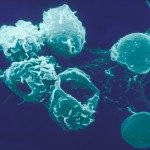Link to Pubmed [PMID] – 29045900
Immunity 2017 Oct;47(4):680-696.e8
The classical model of hematopoiesis established in the mouse postulates that lymphoid cells originate from a founder population of common lymphoid progenitors. Here, using a modeling approach in humanized mice, we showed that human lymphoid development stemmed from distinct populations of CD127(-) and CD127(+) early lymphoid progenitors (ELPs). Combining molecular analyses with in vitro and in vivo functional assays, we demonstrated that CD127(-) and CD127(+) ELPs emerged independently from lympho-mono-dendritic progenitors, responded differently to Notch1 signals, underwent divergent modes of lineage restriction, and displayed both common and specific differentiation potentials. Whereas CD127(-) ELPs comprised precursors of T cells, marginal zone B cells, and natural killer (NK) and innate lymphoid cells (ILCs), CD127(+) ELPs supported production of all NK cell, ILC, and B cell populations but lacked T potential. On the basis of these results, we propose a “two-family” model of human lymphoid development that differs from the prevailing model of hematopoiesis.


